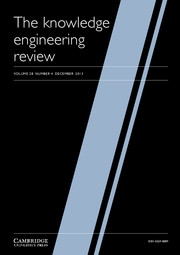Crossref Citations
This article has been cited by the following publications. This list is generated based on data provided by
Crossref.
Feelders, A. J.
1992.
A model of explanation for financial knowledge-based systems.
Computer Science in Economics and Management,
Vol. 5,
Issue. 2,
p.
119.
Fox, John
and
Krause, Paul
1992.
Qualitative frameworks for decision support: lessons from medicine.
The Knowledge Engineering Review,
Vol. 7,
Issue. 1,
p.
19.
Keravnou, E.T.
Washbrook, J.
and
Dams, F.
1993.
Towards competent information acquisition interactions between an expert system and its user.
Knowledge-Based Systems,
Vol. 6,
Issue. 3,
p.
141.
Keravnou, E.T.
Dams, F.
Washbrook, J.
Hall, C.M.
Dawood, R.M.
and
Shaw, D.
1994.
Modelling diagnostic skills in the domain of skeletal dysplasias.
Computer Methods and Programs in Biomedicine,
Vol. 45,
Issue. 4,
p.
239.
Jiye Mao
Dhaliwal
and
Benbasat
1994.
The use of hypertext to provide explanations in knowledge-based systems: a conceptual model and an implementation.
p.
333.
Richard Ye, L.
1995.
The value of explanation in expert systems for auditing: An experimental investigation.
Expert Systems with Applications,
Vol. 9,
Issue. 4,
p.
543.
Mao, Jiye
Benbasat, Izak
and
Dhaliwal, Jasbir Singh
1996.
Enhancing explanations in knowledge‐based systems with hypertext.
Journal of Organizational Computing and Electronic Commerce,
Vol. 6,
Issue. 3,
p.
239.
W˦rn, Yvonne
and
Hägglund, Sture
1997.
Handbook of Human-Computer Interaction.
p.
1159.
MAO, JI-YE
and
BENBASAT, IZAK
2001.
The effects of contextualized access to knowledge on judgement.
International Journal of Human-Computer Studies,
Vol. 55,
Issue. 5,
p.
787.
McSherry, David
2001.
Research and Development in Intelligent Systems XVII.
p.
48.
Mcsherry, David
2001.
Interactive Case-Based Reasoning in Sequential Diagnosis.
Applied Intelligence,
Vol. 14,
Issue. 1,
p.
65.
McSherry, David
2002.
Research and Development in Intelligent Systems XVIII.
p.
39.
Moulin, B.
Irandoust, H.
Bélanger, M.
and
Desbordes, G.
2002.
Explanation and Argumentation Capabilities:Towards the Creation of More Persuasive Agents.
Artificial Intelligence Review,
Vol. 17,
Issue. 3,
p.
169.
Binhua Han
and
Lim, J.
2002.
Influence of culture and explanation facility on performance of negotiation agents.
p.
409.
SAUTER, VICKI L.
and
MADEO, LAURENCE A.
2004.
AN EXPLORATORY ANALYSIS OF THE NEED FOR USER-ACQUAINTED DIAGNOSTIC SUPPORT SYSTEMS.
International Journal of Information Technology & Decision Making,
Vol. 03,
Issue. 03,
p.
471.
McSherry, David
2004.
Advances in Case-Based Reasoning.
Vol. 3155,
Issue. ,
p.
317.
Waern, Y.
and
Ramberg, R.
2004.
Distributed knowledge by explanation networks.
p.
132.
Massie, Stewart
Craw, Susan
and
Wiratunga, Nirmalie
2005.
Applications and Innovations in Intelligent Systems XII.
p.
222.
Leake, David
and
Mcsherry, David
2005.
Introduction to the Special Issue on Explanation in Case-Based Reasoning.
Artificial Intelligence Review,
Vol. 24,
Issue. 2,
p.
103.
Doyle, Dónal
Cunningham, Pádraig
and
Walsh, Paul
2006.
AN EVALUATION OF THE USEFULNESS OF EXPLANATION IN A CASE‐BASED REASONING SYSTEM FOR DECISION SUPPORT IN BRONCHIOLITIS TREATMENT.
Computational Intelligence,
Vol. 22,
Issue. 3-4,
p.
269.

